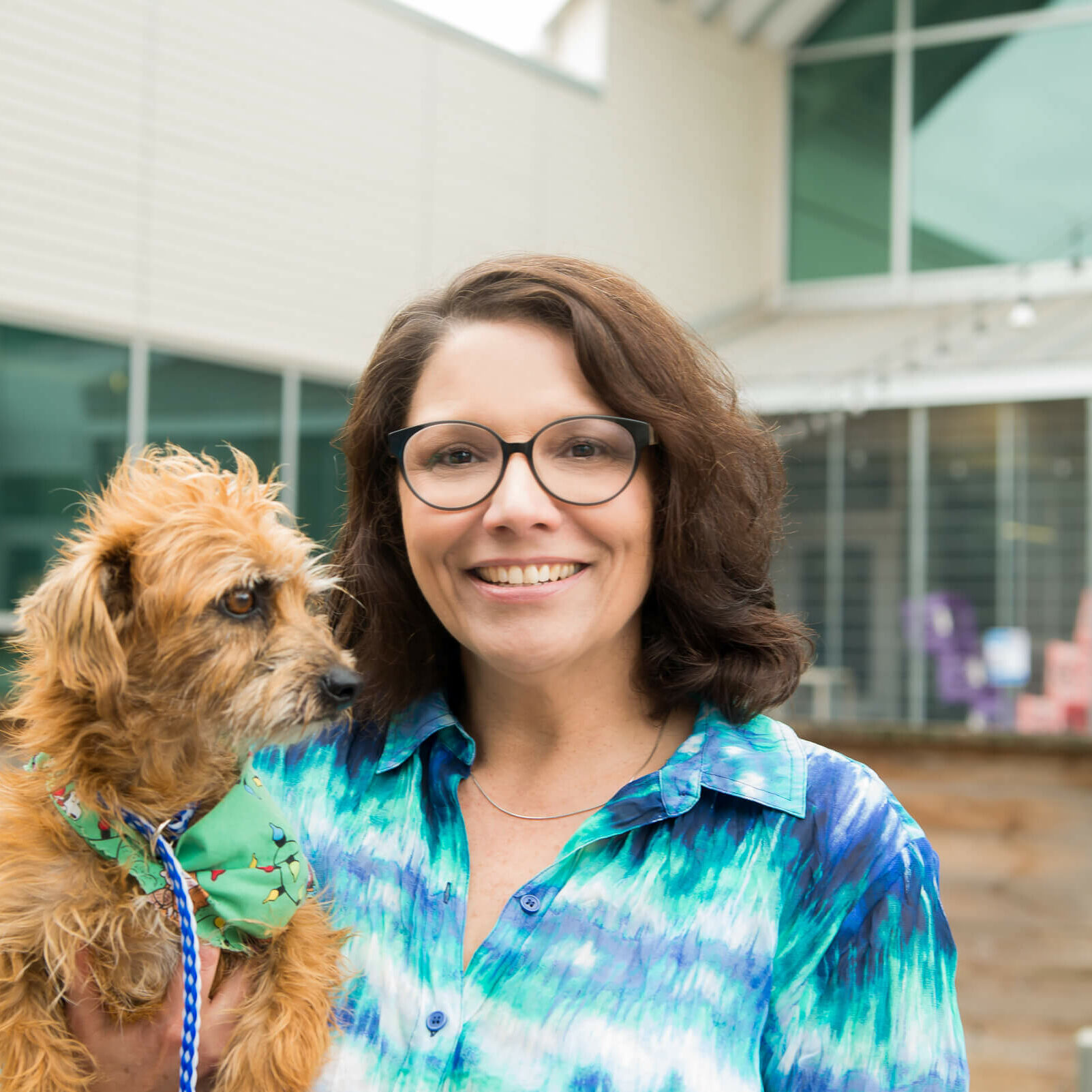If you are expecting your first child, you probably feel excited, but also anxious, especially if you have a dog or cat in the home. You may wonder how your pet will adjust to the new baby and whether the two will get along. Well-intentioned friends and family may offer unsolicited advice, even suggesting that you should get rid of your pet.

There is a lot of misinformation regarding pets and babies. All too often, this results in frightened parents-to-be giving up their best friend right before or shortly after the baby is born. Sadly, many dogs and cats end up at animal shelters when a new baby is expected. And everyone suffers from this separation and loss.
The good news is that you don’t have to give up your furry friend – pets and babies are compatible. In fact, studies have shown that:
• Children who grow up with dogs in the house have a reduced risk of developing allergies.
• Children with pets have higher self-esteem, improved social skills, and are more popular with their peers.
• Children with pets tend to have more empathy for people and animals.
• And, evidence suggests that pets help children develop early non-verbal communication skills.
It’s important to help your dogs and cats prepare for the new arrival. Dogs and cats may suffer stress when their routine is interrupted. A new baby is certainly an interruption in their routine and time spent with you. Some pets may act out by resorting to previous bad behaviors, like chewing or soiling; some may appear jealous; still others may not be affected much at all.
All pets will react differently because how they handle the situation will be determined by two things: how they were raised and how they are treated by you when the baby arrives. If you suddenly push the cat off the bed or the dog out the door when the baby is born, then expect some behavior problems to handle. Get them ready before the new baby arrives and you’re likely find yourself in calmer waters.
Pets can cope with change, as long as it’s gradual and it doesn’t feel as if they are getting punished. As a new parent, there are things you can do to prepare your pet for the baby’s arrival and ensure that everyone adjusts to the newest family member.
Here are some tips to help you prepare your pet for the new baby.
Before the baby is born
• About two months before the birth, begin giving your pet a little less attention. This may sound strange, but once the baby is born, you will automatically be reducing your time with your pet. You want your pet to associate the change in attention before the new baby arrives, and not with the new baby. Never, ever ignore your pet. Just slow down your response time, so that your pet knows he or she may have to wait a few minutes for attention. This will be very helpful when you are nursing the baby or changing a diaper.
• Keep changes to the pet’s routine and living spaces as minimal as possible. If you are moving the pet’s bed or restricting him from any rooms in the house, do so gradually and before the baby is born.
• Decorate the baby’s nursery, so the dog or cat has time to adjust the sights and smells of the baby’s room. This is also a good time to teach the cat not to sleep in the crib. (Place some double stick tape or aluminum foil in the crib so that if the cat does jump into the crib, he or she will jump right back out.) Don’t let your dogs or cats get in the habit of sleeping in the baby’s room. Your pets should never be in the baby’s room unless you are in there too.
• Let your pets check out all the other baby equipment, such as strollers, carriers, mobiles, and other items you will be using with the baby. Some dogs can be afraid of strollers, so it’s important to see how they react to the various equipment that comes from having a baby around.
• Make sure your pet is properly socialized around children. You may not have any kids now, but your dog can be socialized around kids to make them friendlier. Take dogs for walks near playgrounds or invite friends with kids over to the house. But only if you have a good dog to begin with, of course.
* Teach your dog four basic commands: sit, stay, come, and down. Train your dog in the nursery, in the kitchen, while pushing a stroller, and even while sitting in the rocking chair where you will nurse your baby. Dogs need to learn new skills in a variety of places, with you both sitting and standing, so that they learn to listen to you no matter where you are or what you are doing.
• Get both dogs and cats used to being touched, especially around the tails and ears, so that they are more patient with young hands in the future.
When the Baby is Born
• Have someone bring clothing or blankets covered with the baby’s smell home to the pet. Do not drop these items on the pet’s favorite sleeping place or bed, but place them somewhere that the pet can easily smell or rest on them. This allows the pet to become familiar with the scent before the baby comes home.
• When the baby comes home, have someone other than the mom walk into the room with the baby. This gives mom a chance to pet the dog or cat before sitting down with the baby, and keeps the dog from jumping on mom while holding the baby. First introductions should always be calm.
• Let the dog and cat sniff the new baby. Dogs will approach, sniff, and back off—and they repeat that cycle. Cats will come around in their own time. Never force any pet to come near or be around the baby. In fact, your pet should have a place to escape, like a crate, where he can get away from everyone if it all becomes too much. If your dog becomes too rambunctious or out of control, put him on a leash so that you have some control until he calms down.
Multiple dogs can meet all at once if they are friendly. However, sometimes its best to introduce the dogs one at a time so that every dog has a chance to form a good first impression.
• If your dog growls, say “no” firmly. Your dog will likely walk away. If not, you can put the dog in his crate for a little while.
• Cats require no introductions. Do not pick up the cat and carry them over to meet the baby. Allow cats to come around in their own time. That could be right away or six months from now.
• Cats don’t require any advanced training. But they may react to the baby’s crying by fleeing and hiding under the bed. That’s okay, just make sure your cat always has an escape route.
• Do not let your dog or cat or other pets sleep with your baby. Your baby is helpless and would not be able to move a pet that cuddled to closely. Pets should not sleep in the baby’s room. When the baby goes down for nap, ask all the pets to follow you out of the room.
• Before the baby arrived, you gave your pet a little less attention. Now make sure that you give your pet lots of attention when the baby is present. Speak to the pet as you feed the baby or change her diapers. This helps the bonding experience, as the pet learns that fun and interaction occur when the baby is present. This reassures your pet that he is still part of the family and shows him that the baby is now part of your family too.
• When the baby takes a nap, you take a nap too. Don’t use the time to suddenly give your pet attention. They will associate attention with the baby being away. All attention and activities should be given when the baby is present: The pet will then learn that love and fun happen whenever the baby is around. Do this for a few weeks or months — until you feel the pet is no longer insecure around the baby.
• NEVER, EVER LEAVE YOUR PET ALONE WITH YOUR BABY. Regardless of your pet’s temperament, pets should never be left unsupervised with a baby, toddler, or child under 8-years-old. This basic rule of thumb will protect your baby from an excited pet and will protect your pet from a normal child curious about ears and tails.
• If your dog or cat ever appears agitated or annoyed around children, remove them from the kids immediately. You can place them in their kennel crate or in a quiet place, like a bedroom, for a little while.
Pets are part of the family and can remain part of the family with a little planning and patience. Children benefit greatly from growing up with pets. The efforts you put forth now in helping everyone adjust will be seen later when you see how happy your child is to have a dog or cat as a friend.




Thanks for sharing your blog with all of us, very imformative.
For a great example of pet/infant introduction and normal interaction, please reference “Marley and Me,” a sweet romantic-comedy released about a month ago. Your advice is right on target. Most importantly, NEVER leave your young child in the same room with your pet unsupervised.